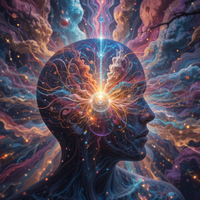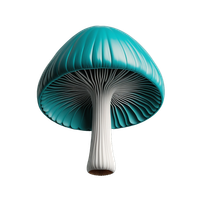Microdosing Mushrooms: How it Works
Learn about microdosing and using magic mushrooms for mental wellness and enhancing your mind!
Microdosing with psilocybe mushrooms typically involves taking a sub-perceptual dose of psilocybin, the active compound in these mushrooms, to potentially enhance mood, creativity, and cognitive function without experiencing the full psychedelic effects.

Microdosing Protocols
Summary - Read further below for our detailed guide on microdosing!
Fadiman Protocol:
Dosage: 0.1 to 0.3 grams of dried psilocybin mushrooms.
Schedule: Take the dose every three days. For example, take a microdose on Day 1, have a break on Day 2, and take another on Day 3. Repeat this cycle.
Schaefers Protocol:
Dosage: Similar range, around 0.1 to 0.3 grams.
Schedule: Microdose every other day. This allows for more frequent dosing while giving the body a rest day in between.
Stamets Stack:
Dosage: 0.1 to 0.3 grams of psilocybin mushrooms, often combined with lion's mane mushroom (Hericium erinaceus) and niacin (vitamin B3).
Schedule: Similar to the Fadiman Protocol, but with a focus on cognitive benefits and neurogenesis from the additional mushrooms.
Custom Protocols: Some individuals prefer to develop their own schedules based on personal experience and effects, often keeping a journal to track mood and cognition.

General Considerations:
Sourcing: Ensure you have a reliable source of psilocybin mushrooms.
Safety: Start with a low dose to assess tolerance and effects.
Mindset: Approach microdosing with intention and mindfulness.
Duration: Some users recommend trying a protocol for several weeks before evaluating its effectiveness.
Note: While many users report positive effects, the scientific research on microdosing is still in its early stages, and it's important to consider legal and health implications based on your location. Always consult a healthcare professional if you're considering it for therapeutic purposes.
Recommended products:
Pacific Spirit Microdose 200mg
Pacific Spirit Low Microdose 100mg
Be Here Now 150mg Microdose and Biohack
Microdosing Magic Mushrooms: A Comprehensive Guide to Protocols, Benefits, Safety, and Cultural Impact
-Lawrence Anderson
Microdosing magic mushrooms, particularly strains like Golden Teacher (Psilocybe cubensis), has gained significant traction as a wellness practice for enhancing mental health, creativity, and overall well-being. This detailed article explores optimized microdosing protocols, the multifaceted benefits (including neuroplasticity, cognitive enhancement, stress relief, addiction recovery, energy, and mood improvement), practical details on dosing and scheduling, safety considerations, and its presence in popular culture. It also covers major microdosing protocols, the science behind its mental wellness benefits, and its potential to positively impact society.
What is Microdosing?
A microdose is typically 1/10th to 1/20th of a full psychedelic dose, ranging from 0.1 to 0.3 grams of dried Psilocybe cubensis.
Microdosing involves taking sub-perceptual doses of psychedelics, such as psilocybin-containing mushrooms, to achieve subtle therapeutic or cognitive benefits without inducing hallucinations or significant alterations in consciousness. A microdose is typically 1/10th to 1/20th of a full psychedelic dose, ranging from 0.1 to 0.3 grams of dried Psilocybe cubensis. The practice aims to enhance mental clarity, emotional resilience, and physical energy while allowing individuals to remain fully functional in daily life.
Microdosing has roots in both traditional Indigenous use of psilocybin for healing and the modern psychedelic renaissance, popularized by figures such as Dr. James Fadiman and Paul Stamets. Its appeal lies in its accessibility, low risk, and potential to address a wide range of mental and emotional challenges.
Optimized Microdosing Protocols
Several microdosing protocols exist, each designed to balance benefits, minimize tolerance, and suit individual lifestyles. Below are the major protocols, with details on their structure and application:
1. Fadiman Protocol
• Creator: Dr. James Fadiman, a pioneer in psychedelic research.
• Structure: Microdose every third day (e.g., Day 1: dose, Day 2: no dose, Day 3: no dose, Day 4: dose).
• Example: Monday (0.1 grams), Thursday (0.1 grams), Sunday (0.1 grams).
• Duration: 4–8 weeks, followed by a 2–4 week break to reset tolerance.
• Rationale: The 2-day gap prevents tolerance buildup, as psilocybin’s effects on serotonin receptors typically reset within 48–72 hours. The protocol emphasizes integration, with non-dosing days used for reflection and journaling.
• Best For: Beginners, those seeking cognitive or emotional benefits, and individuals with busy schedules.
2. Stamets Protocol (Stacking)
• Creator: Paul Stamets, a renowned mycologist.
• Structure: Microdose for 4 consecutive days, followed by 3 days off (e.g., Monday–Thursday: dose, Friday–Sunday: no dose).
• Combines psilocybin (0.1–0.3 grams) with Lion’s Mane mushroom (500–1000 mg, a non-psychedelic nootropic) and niacin (50–100 mg, vitamin B3) in a “stack.”
• Duration: 4–6 weeks, followed by a 2–4 week break.
• Rationale: Lion’s Mane promotes neurogenesis, niacin enhances circulation, and psilocybin boosts neuroplasticity, creating a synergistic effect. The 4-day dosing period is more intensive but balanced by a longer break to prevent tolerance.
• Best For: Individuals focused on cognitive enhancement, neuroplasticity, or neurological health.
3. Every-Other-Day Protocol
• Structure: Microdose every other day (e.g., Day 1: dose, Day 2: no dose, Day 3: dose).
• Example: Monday, Wednesday, Friday dosing.
• Duration: 6–8 weeks, followed by a 2–4 week break.
• Rationale: This protocol offers a more frequent dosing schedule for those needing consistent mood or energy support, while still allowing a day for receptor recovery to minimize tolerance.
• Best For: Those managing chronic stress, anxiety, or depression.
4. Intuitive Protocol
• Structure: Microdose on an as-needed basis, guided by personal intuition or specific goals (e.g., before a creative project or stressful event).
• Duration: Variable, with breaks recommended every 4–6 weeks.
• Rationale: This flexible approach suits experienced users who understand their body’s response to psilocybin and can dose strategically without a fixed schedule.
• Best For: Experienced microdosers or those with irregular schedules.
Optimized Protocol Recommendations
• Dosage: Start with 0.1 grams of dried Psilocybe cubensis (e.g., Golden Teacher) to assess sensitivity. Adjust to 0.15–0.3 grams after 1–2 weeks if effects are too subtle, using a precision scale (accurate to 0.01 grams) for consistency.
• Schedule: The Fadiman Protocol is recommended for most users due to its simplicity, low tolerance risk, and balance of benefits and integration. The Stamets Protocol is ideal for those prioritizing cognitive or neurological benefits.
• Cycle Length: 8–12 weeks, followed by a 2–4 week break to reset tolerance and evaluate long-term effects.
• Administration: Take in the morning with food or as tea to reduce nausea. Capsules or ground powder ensure accurate dosing.
• Integration: Use non-dosing days for journaling, meditation, or therapy to process insights and track progress.
Benefits of Microdosing
Microdosing psilocybin offers a wide range of potential benefits, supported by anecdotal reports, preliminary research, and emerging clinical studies. Below are the key benefits, with a focus on their physiological and neurological mechanisms:
1. Neuroplasticity
• Mechanism: Psilocybin upregulates brain-derived neurotrophic factor (BDNF) and promotes dendritic spine growth, even at microdose levels. This enhances neural plasticity, allowing the brain to form new connections and adapt to new behaviors or thought patterns.
• Benefit: Increased neuroplasticity supports learning, memory, and the ability to break rigid mental habits. This is particularly valuable for overcoming maladaptive patterns associated with addiction, depression, or anxiety.
• Evidence: A 2021 study in Nature found that psilocybin enhances synaptic plasticity in mice, with effects persisting beyond the acute dose. Anecdotal reports describe improved problem-solving and adaptability.
2. Cognitive Benefits
• Mechanism: Microdosing subtly stimulates serotonin 5-HT2A receptors in the prefrontal cortex, enhancing cognitive flexibility, focus, and creativity. It may also increase blood flow to brain regions involved in executive function.
• Benefit: Users report improved concentration, creative problem-solving, and divergent thinking. Microdosing is popular among professionals in tech, arts, and academia for boosting productivity and innovation.
• Evidence: A 2019 study in Psychopharmacology found that microdosing improved convergent and divergent thinking in healthy adults. Anecdotal reports from platforms like Third Wave highlight enhanced workflow and idea generation.
3. Stress Relief
• Mechanism: Psilocybin reduces activity in the amygdala (the brain’s fear center) and modulates the hypothalamic-pituitary-adrenal (HPA) axis, lowering cortisol levels and stress responses.
• Benefit: Microdosing promotes calmness, resilience to stressors, and a sense of emotional balance. It may help individuals manage workplace stress, social anxiety, or chronic tension.
• Evidence: A 2020 study in Scientific Reports reported reduced stress and anxiety in microdosers, with effects persisting on non-dosing days.
4. Addiction Recovery
• Mechanism: Psilocybin downregulates dopamine-driven reward pathways in the mesolimbic system and enhances prefrontal cortex control, reducing the salience of substance-related cues. It also quiets the default mode network (DMN), decreasing obsessive thoughts.
• Benefit: Microdosing may reduce cravings for substances like alcohol, nicotine, or opioids, while improving self-awareness and motivation for recovery. It supports the formation of healthier habits by enhancing neuroplasticity.
• Evidence: High-dose psilocybin studies (e.g., Johns Hopkins, 2015) show significant reductions in smoking and alcohol use. Anecdotal reports on Reddit’s r/microdosing suggest microdosing helps with craving management and emotional regulation.
5. Energy and Motivation
• Mechanism: Microdosing may increase dopamine and serotonin signaling, enhancing motivation and physical energy. It also improves sleep quality in some users, contributing to daytime vitality.
• Benefit: Users report increased drive, stamina, and enthusiasm for daily tasks, making microdosing appealing for combating fatigue or low motivation.
• Evidence: Anecdotal reports describe a “high-definition” sense of energy and engagement, though controlled studies are limited.
6. Mood Elevation
• Mechanism: Psilocybin’s action on serotonin receptors stabilizes mood and reduces DMN hyperactivity, which is linked to rumination and negative thought patterns. It may also have anti-inflammatory effects, improving mood by reducing neuroinflammation.
• Benefit: Microdosing alleviates symptoms of depression, anxiety, and emotional instability, promoting optimism and emotional clarity. It is often described as a “mood reset.”
• Evidence: A 2021 study in Scientific Reports found that microdosing psilocybin improved mood and emotional well-being in healthy adults, with effects comparable to SSRIs in some cases.
7. Additional Benefits
• Social Connection: Microdosing enhances empathy and interpersonal openness, improving relationships and communication.
• Physical Health: Preliminary studies suggest psilocybin has antibacterial, antioxidant, and anti-inflammatory properties, potentially supporting overall wellness.
• Spiritual Insight: Microdosing fosters a sense of interconnectedness and purpose, aligning with mindfulness and meditative practices.
How to Microdose: Dosage, Spacing, Tolerance, and Acclimation
Dosage, Spacing, Tolerance, Acclimation, Tips!
Dosage
• Range: 0.1–0.3 grams of dried Psilocybe cubensis (e.g., Golden Teacher). Start at 0.1 grams to assess sensitivity, increasing to 0.15–0.2 grams if needed.
• Measurement: Use a precision scale (0.01-gram accuracy). Grind mushrooms into powder for consistent dosing, encapsulating or mixing with food/drink (e.g., tea, smoothies).
• Strain Considerations: Golden Teacher is ideal due to its moderate potency (0.61–1.2% psilocybin). Stronger strains (e.g., Penis Envy) may require lower doses (e.g., 0.05–0.15 grams).
Spacing
• Recommended Schedule: Follow the Fadiman Protocol (every third day) or Stamets Protocol (4 days on, 3 days off) to balance benefits and prevent tolerance.
• Integration Days: Use non-dosing days for reflection, journaling, or therapy to process subtle changes in mood or behavior.
Tolerance
• Mechanism: Psilocy Psilocybin induces tolerance by desensitizing serotonin 5-HT2A receptors, reducing effectiveness with frequent use. Spacing doses 48–72 hours apart prevents significant tolerance buildup.
• Management: Adhere to a structured protocol with regular breaks (2–4 weeks after 8–12 weeks) to reset sensitivity. Avoid daily dosing, as effects may diminish within days.
Acclimation
• Initial Phase: Start with 0.1 grams for 1–2 weeks to acclimate. Subtle changes in mood, energy, or focus may emerge gradually.
• Adjustment: If effects are too mild, increase by 0.05-gram increments. If side effects (e.g., mild anxiety, overstimulation) occur, reduce the dose or extend the dosing interval (e.g., every fourth day).
• Monitoring: Track experiences in a journal to identify optimal dose and schedule. Consult a healthcare provider or integration specialist if unsure.
Practical Tips
• Timing: Take in the morning to align with circadian rhythms and avoid sleep disruption.
• Environment: Dose in a calm, supportive setting, ideally with access to therapy or support networks.
• Preparation: Store mushrooms in a cool, dry, dark place to preserve potency. Use Lemon Tek (mixing with citrus juice) or tea to enhance onset and reduce nausea.
Safety of Microdosing
Microdosing is generally safe when approached responsibly, but precautions are essential.
Safety Profile
• Low Physiological Risk: Psilocybin is non-addictive, has low toxicity, and poses minimal risk to organ health at microdose levels.
• Side Effects: Mild anxiety, overstimulation, fatigue, or gastrointestinal discomfort may occur. These are dose-dependent and resolve by lowering the dose or pausing.
• Mental Health Risks: Avoid microdosing if diagnosed with psychosis, schizophrenia, or bipolar disorder, as psilocybin may exacerbate symptoms. Those with severe anxiety or PTSD should consult a professional.
• Drug Interactions: Psilocybin has minimal interactions but may interact with SSRIs, SNRIs, or MAOIs. Consult a physician if on psychiatric medications.
Safety Precautions
• Legal Status: Psilocybin is illegal in most countries (e.g., U.S. Schedule I), except in decriminalized regions (e.g., Oregon, Colorado). Verify local laws.
• Source Quality: Use lab-tested mushrooms or sterile spores to avoid contamination. Home cultivation requires strict hygiene to prevent mold or bacteria.
• Supervision: Work with a therapist, integration coach, or healthcare provider, especially if managing mental health conditions or addiction.
• Set and Setting: Dose in a safe, familiar environment. Avoid combining with alcohol or other substances.
Why Microdosing Can Help Mental Wellness and Society
Microdosing holds transformative potential for mental wellness and societal well-being by addressing individual and collective challenges:
Mental Wellness
• Mood Disorders: By modulating serotonin and reducing DMN hyperactivity, microdosing alleviates depression, anxiety, and PTSD symptoms, offering an alternative to traditional antidepressants.
• Addiction Recovery: Microdosing reduces cravings and enhances neuroplasticity, supporting recovery from substances like alcohol, opioids, or nicotine.
• Cognitive Health: Enhanced neuroplasticity and BDNF upregulation may protect against cognitive decline and support lifelong learning.
• Emotional Resilience: Microdosing fosters empathy, self-awareness, and emotional clarity, improving relationships and mental stability.
Societal Impact
• Mental Health Crisis: With rising rates of depression and anxiety, microdosing offers a low-cost, accessible tool to complement therapy and medication, potentially reducing healthcare burdens.
• Creativity and Innovation: By boosting cognitive flexibility, microdosing can drive innovation in technology, arts, and science, fostering societal progress.
• Empathy and Connection: Microdosing’s prosocial effects may reduce polarization and promote collective understanding, addressing societal division.
• Sustainability: As a natural compound, psilocybin aligns with eco-conscious movements, encouraging sustainable wellness practices.
Supporting Evidence
• Research: Studies (e.g., Scientific Reports, 2021; Psychopharmacology, 2019) confirm microdosing’s benefits for mood, cognition, and stress. High-dose psilocybin trials (e.g., Johns Hopkins) suggest similar mechanisms at lower doses.
• Anecdotal Reports: Platforms like Erowid and Third Wave document thousands of positive experiences, with users reporting improved mental health and life satisfaction.
• Decriminalization: Cities like Oakland, Denver, and Vancouver have decriminalized psilocybin, reflecting growing societal acceptance and demand for psychedelic wellness.
By empowering individuals to manage their mental health and fostering creativity and empathy, microdosing can contribute to a more resilient, connected, and innovative society.
Microdosing in Popular Culture
Microdosing has become a cultural phenomenon, particularly in wellness, tech, and creative communities:
• Tech Industry: Silicon Valley professionals, including entrepreneurs and programmers, embrace microdosing for creativity, focus, and problem-solving. Articles in Forbes and Wired (2015–2020) highlight its popularity in tech hubs.
• Media and Literature: Books like A Really Good Day by Ayelet Waldman and How to Change Your Mind by Michael Pollan explore microdosing’s impact on mood and productivity. Podcasts like The Psychedelic Salon and Third Wave discuss its benefits.
• Social Media: Reddit’s r/microdosing and Instagram communities share trip reports, cultivation tips, and testimonials. Posts like “Microdosing Changed My Life” garner thousands of engagements.
• Wellness Movement: Microdosing is featured in wellness blogs (e.g., Psychedelic Spotlight, DoubleBlind) and retreats, aligning with mindfulness, yoga, and biohacking trends.
• Celebrity Endorsements: Figures like Joe Rogan and Gwyneth Paltrow have discussed psychedelics, indirectly boosting microdosing’s visibility.
Microdosing’s cultural rise reflects a broader shift toward destigmatizing psychedelics and integrating them into mainstream wellness practices.
Final Thoughts on Microdosing’s Impact on Mental Wellness and Society
Disclaimer: This article is for informational purposes only. Consult a healthcare provider before starting microdosing, and verify local psilocybin laws.
Microdosing magic mushrooms offers a versatile and low-risk approach to enhancing mental wellness, cognitive function, and emotional resilience. Optimized protocols, such as the Fadiman and Stamets methods, balance benefits with tolerance management, while careful dosing and spacing ensure safety and efficacy. The practice’s benefits—spanning neuroplasticity, stress relief, addiction recovery, and mood elevation—are grounded in neurological mechanisms and supported by emerging research.
As microdosing gains traction in popular culture and wellness communities, it holds promise for addressing individual mental health challenges and fostering societal progress. By approaching microdosing with intention, education, and professional guidance, individuals can unlock its potential to transform their lives and contribute to a more compassionate, creative world.
Resources:
• How to Change Your Mind by Michael Pollan
• Third Wave (thethirdwave.co)
• Johns Hopkins Center for Psychedelic Research
• Psilopedia.ca
• Reddit’s r/microdosing
-Pacific Spirit 100mg, 200mg
-Be Here Now 150mg and Biohack
